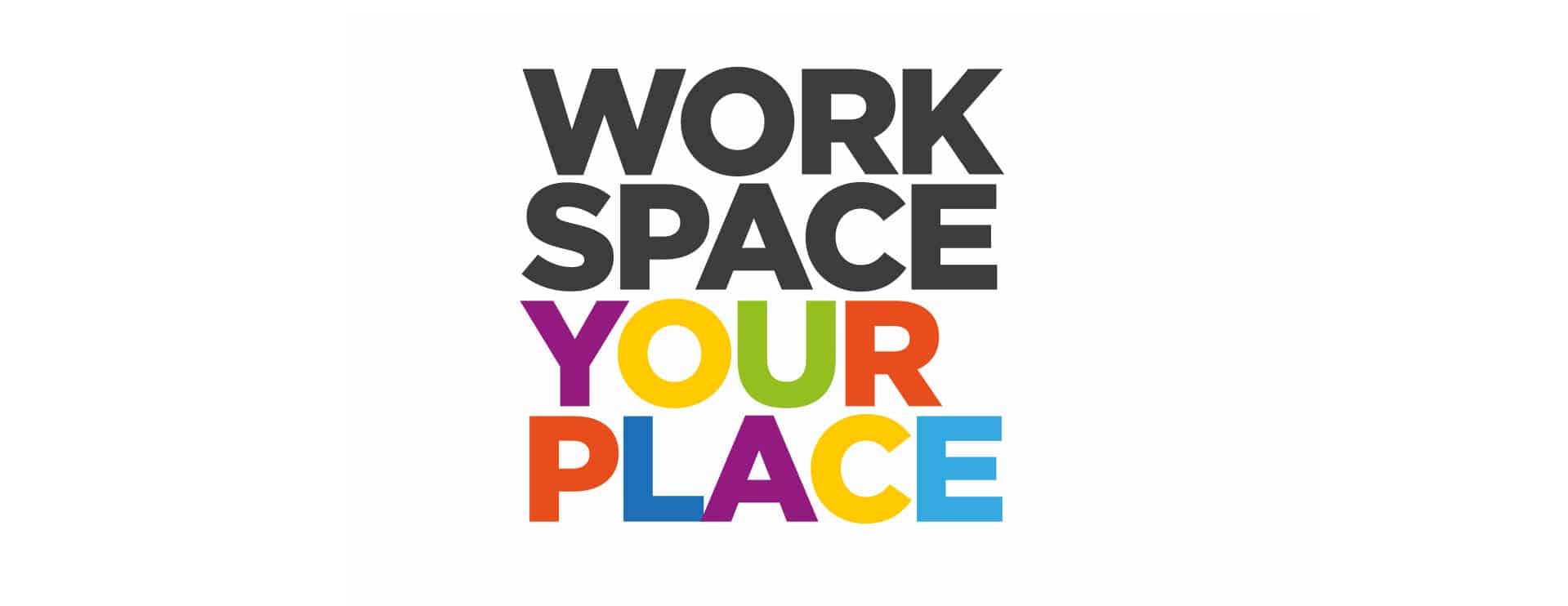IGEL Blog
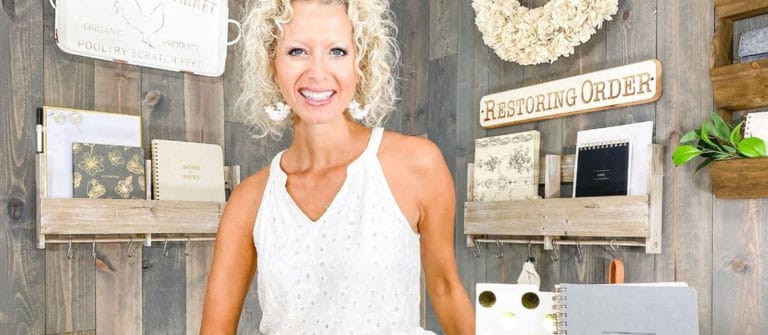
Declutter Your Workspace
If your workspace is cluttered, your mind and productivity likely are, too! Read and apply these steps to streamline your space and you’ll receive payoff in both visual and mental clarity! In this blog, I’m revealing 3 common mistakes that clutter up our workspace and hamper efficiency.
A workspace layered with archaeology is not only ugly to look at, but it stymies our productivity before we even get started.
Junky surfaces are ugly and embarrassing. They usually represent that:
- We have too much on our plate; our stuff is outpacing our bandwidth, or:
- We haven’t taken the time to prioritize a functional workspace, or, worse:
- Our internal world (a hot mess) is manifesting in our external world
Whatever your reason(s) may be for clutter to call your workspace “home,” this blog will help you analyze how-you-got-here and what to do about it!
Mistake #1 – Office Supply Abuse
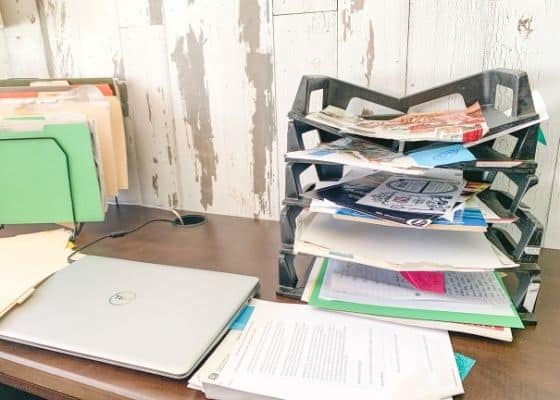
Office products were of course invented to help us corral our clutter on our desks, credenzas, and work surfaces, but many of us over-or-under apply them, and generally mis-use them!
I call this phenomenon “office supply abuse” – and it’s the first mistake that leads to workspace messes.
Office supply abuse happens when we believe that buying and throwing organizing products at our problem is the answer.
Let’s face it: most of us don’t want to dedicate several hours to getting to the root of our organizing problems. We “awfulize” how long that would take. We don’t want to expose ourselves to the self-scrutiny, and bring our own habits under the magnifying glass. It’s painful and yucky.
It’s SO much easier to be enticed by a cute-sy tray system or file sorter or implement organizer, and just drop some money on accessories and throw those at the mess. We pay money instead of the piper because we want to avoid the process and just get to the finish line faster.
However, after 21 years as a professional organizer, I can tell you that I’ve seen thousands of households with a huge range of products, and they’re STILL disorganized!
It’s not products alone that solve our problems; it’s the organizing PROCESS we go through! Products may likely be part of the solution; but it’s the questions we ask of ourselves, the discovery process itself, that rids us of clutter and creates ordered systems.
Office supply abuse happens when we short-circuit the organizing process and replace it with organizing “tools” that don’t last or fit your needs.
Instead, here’s how to ensure you get the right organizing tools and avoid office supply abuse for good:
- Don’t buy junk. It may be hard to spend good money on lasting accessories, but you will pay the price in aesthetics if you just grab the cheap plastic stuff. Leave the cheap-o products on the shelf, and take the time to find the right products in quality materials that suit your actual needs.
- Don’t buy too soon in the process. It’s too easy to be enticed by trendy or sparkly products, especially ones with cute labels or features. We grab the product off the shelf, and bring it back to our workspace, and then try to retro-fit it to our needs. This is the opposite of what we should be doing. Instead, we should clear out the “deadwood” off our surfaces and walls, organize the paper and “stuff” that remains by type, and custom-fit our products to our daily-use items. Let the PROCESS guide your organizing efforts; not the PRODUCTS!
- Determine inventory first. As you go through the sorting process, you will be making decisions about what gets to live on your surfaces, based on frequency-of-use. Instead of buying a sorter for specific files or certain supplies, in the end, you may put those items in a drawer after you’ve prioritized your workspace real estate. This is why the sorting process is so important: during the sort, you will take visual “inventory” of all your stuff and the resulting decisions should guide the products you acquire. This is key to avoiding office supply abuse.
- Don’t buy without measuring. This may seem obvious, but again, we get enticed by a multi-drawer caddy or a sleek bleachered file system, and we too often buy it before we measure our workspace and the items we want to store. Measure first, then buy.
Now that you’ve learned how to buy the right products at the right time, you are on your way to decluttering your workspace systems.
But what about the walls that surround us? Many of us have let our clutter creep upward and pretty soon we are enveloped by it…
Mistake #2 –Visual Clutter
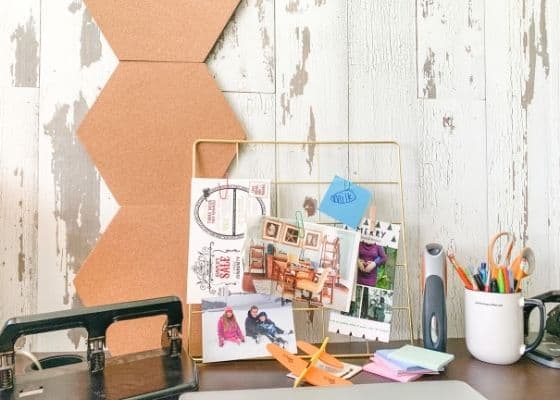
In an attempt to get organized or even beautify our space we often mindlessly tack space-cluttering “organizers” or elements to our walls.
From bulletin boards to white boards, to a random scattering of wall art, we often begin with good intentions.
We want to encircle ourselves with inspiration, so we begin taping, tacking, and displaying everything from vision boards to memorabilia to reminders. Pretty soon, our walls become just as visually “noisy” as our desktops.
Step back and take a fresh look at your wall space and see if you’re committing the second mistake of cluttered offices: visual clutter.
In our passion to “personalize” our space, we display:
- Family pictures
- Holiday and greeting cards
- Knick knacks that remind of us of events or funny memories
- Reminders
- Inspiration
- Décor items that haven’t been planned or don’t coordinate
In the above photo, we see a metal grid “organizer” that is sold in many varieties today, both in stores and online. But what are you supposed to hang on this grid system? Pictures? These grids are clutter-catchers! They are artfully designed in the advertisement, but are rarely executed that way in real life.
Also pictured are hexagon bulletin boards. Many stores sell “collections” of these kind of corkboards or mirrors, etc. The idea – I suppose – is to make your display items into a gallery. However, these mini boards simply add to the chaos and hem in the space visually.
If you don’t want your home office to look like the inside of a teenage locker, quit buying space-cluttering stuff that doesn’t have a useful purpose.
Instead, give your walls a makeover in the same way you would your desktop and surfaces:
- Take a fresh designer look at your walls
- Empty everything off them if you’re a victim of visual wall clutter
- Put only the items back that enhance the space
- Acquire attractive pieces that optimize the space
- Consider less, larger statement pieces to visually expand your space
For those who love to display memorabilia, clutter often follows. But, with a little forethought, you can find ways to do it elegantly and without visual noise:
- Photograph awards and put them in an album
- Remove photo frames scattered on walls and surfaces, and instead display them in a slideshow on your computer monitor or a wall-mounted screen
- Blow up special quotes littered around your space and create a canvas wall art, or have a vinyl saying made for your walls
Now that you’ve reigned in your office supply systems and decluttered your walls, let’s streamline the “stuff” that helps us work: our staplers, pens, sticky notes, and related paraphernalia.
Mistake #3 – Surface Yard Sale
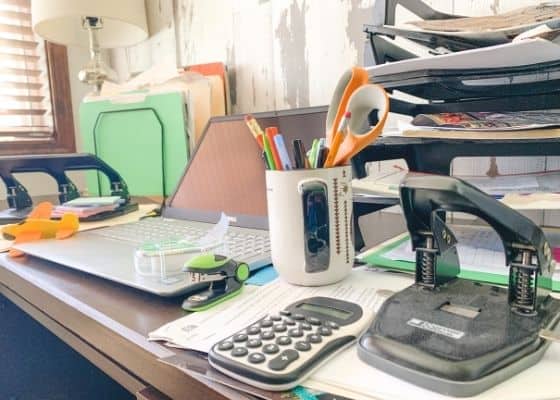
Can we talk about SURFACE abuse? Anything and everything hits our surfaces, and without careful planning, our work surface starts looking like a disorganized yard sale.
The third and final mistake that clutters up our workspace is allowing a “surface yard sale” to occur.
Sometimes this mistake is hard to “see” in our own workspace, because we become so used to our familiar items being “on hand,” that we allow this junky little stuff to take over.
My advice to prevent the proliferation of junk is to take an “aerial view” of your space. Literally get on a chair and look down at your desk. Or, take a photo of it and analyze it. The idea is to get fresh eyes on your work surfaces and evaluate attractiveness and efficiency.
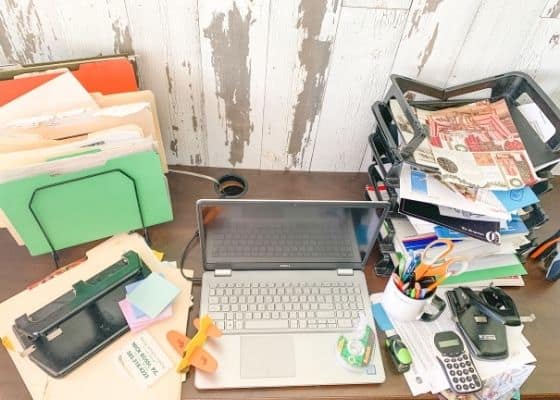
Sticky note dispensers, three-hole punches, calculators, and other desktop equipment litters our space if we aren’t careful.
Even if we use these items fairly frequently, not all of them need to be on our desk.
- Some could be relocated to an “assembly station” on a counter or credenza, like a stapler and hole punch.
- Specific items could be placed in a top desk drawer, to keep often-used items close at hand, but not in view
- Some items are hardly used at all, and can be placed in a supply closet or cabinet for infrequent use. Tape, for example, is not used very often in most workflows. So, no matter how attractive your dispenser is, you really don’t need to leave it on your work surface!
The remedy for surface abuse is to zoom out and view your space with fresh eyes. Ask yourself how often you use each item and whether it needs to live on the surfaces.
Here are two common surface clutterers:
Mug full of pens – instead, consider a divided pencil station on your desktop to organize your writing instruments by type: markers, pens, pencils, and highlighters – or use a drawer organizer and put these out of sight.
“Everything” caddy – ill-sized organizers that catch odds-and-ends because they’re not big enough for a file or normal size paper, and it’s unclear what should go inside them. Instead, follow the instructions to remedy “office supply abuse” above.
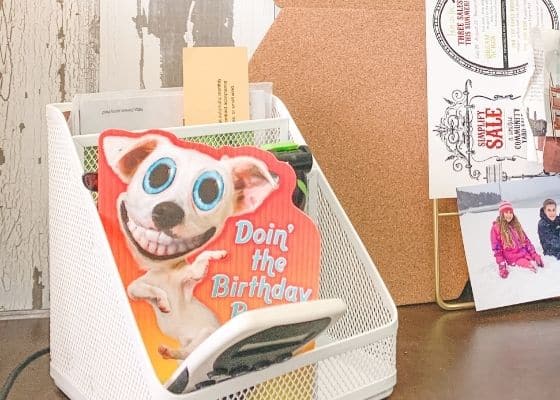
It may be time to evaluate the mish-mash parking lot of your desk and take back your visual aesthetic. You will uplevel your workspace when you reclaim your surfaces!
Declutter to Improve Focus

Dejunking your walls and surfaces improves the aesthetic as well as your focus.
A clear, open surface invites you to tackle your work unobstructed. It’s easy on the eye and feels manageable.
If it’s time to declutter your workspace, here’s your prescription:
- Clear off your surfaces – both vertical and horizontal and revisit your “look”
- Simplify the STUFF, put little things out of sight
- Invest in fewer, quality, attractive products
Decumulating and streamlining your workspace will pay dividends in how it looks and feels. As a bonus, you’ll be empowered to get after your work like never before, resulting in improved productivity and satisfaction.
Here’s to reclaiming your surfaces and enjoying your workspace once more!
~Vicki Norris

